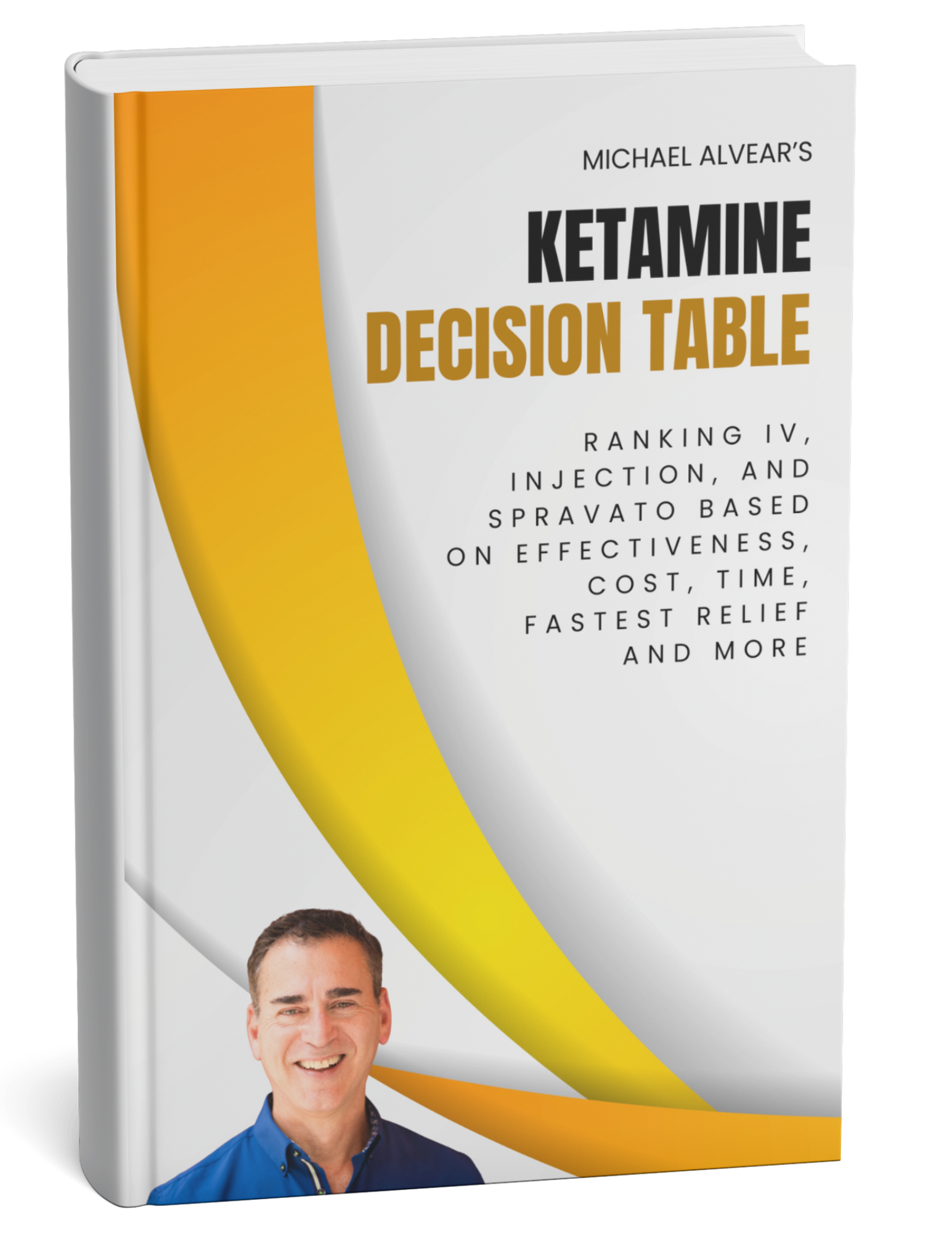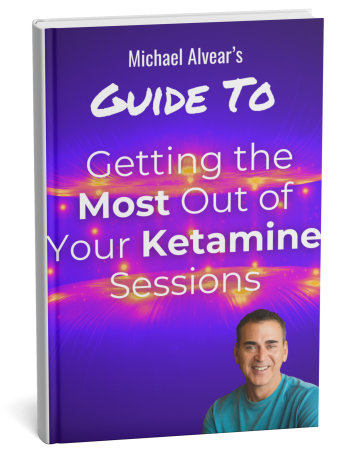The Complete Guide To Oral & Sublingual Ketamine for Depression
By Michael Alvear, Health Author & Independent Researcher
My research is published on these scholarly platforms:
Last Updated:
Can’t Decide Between IV, Injections, Or Spravato?
Use My Decision Table

This report ranks all three options—IV, injection, and Spravato—on effectiveness, cost, fastest relief, and more, giving you a clear framework to decide.
Downloads as PDF • 5 minute read
How Many Oral Ketamine Treatments Will You Need?
Understanding Treatment Duration
This article won’t tell you how many oral or sublingual ketamine treatments you personally “should” have. Instead, it explains why that simple-sounding question is so hard to answer, how research trials, telehealth ketamine companies, and real-world prescribers all handle dosing very differently, and what that means for anyone trying to plan a course of treatment.
If you’re trying to figure out how many oral or sublingual ketamine treatments you’ll “need” for depression, you’ve probably already noticed something strange: nobody gives you a clear number. That’s not an accident. For oral and sublingual ketamine, there is no agreed-upon protocol the way there is for the FDA-approved nasal spray or for IV infusions.[1][2]
Where There Is a Roadmap: Nasal Spravato and IV/Injection Ketamine
For the nasal spray version of esketamine (Spravato), the FDA has signed off on a detailed schedule. For treatment-resistant depression, the official dosing starts with twice-weekly treatments for 4 weeks, then once a week in weeks 5–8, and then once weekly or every 2 weeks from week 9 onward, with benefit re-evaluated after the first month.[1] You can debate the protocol, but at least it exists.
IV and intramuscular ketamine are not FDA-approved for depression, but over the last decade, clinics and consensus statements have converged on a fairly consistent “best practice”: about 6–8 low-dose infusions over 2–4 weeks as an acute series, followed by less frequent maintenance infusions only if you respond.[2][3] Again, not perfect, but there is at least a recognizable pattern most programs follow.
Where There Is No Roadmap: Oral and Sublingual Ketamine
Oral and sublingual ketamine live in a different world. There is no FDA-approved depression indication, no label-approved schedule, and no professional guideline that says, “You should get X oral doses or Y sublingual sessions.” Major reviews of oral ketamine repeatedly note that dosing and frequency are heterogeneous and that we do not yet have enough data to recommend a standard number of treatments.[4][5]
In research trials, oral and sublingual ketamine are usually given in short, defined courses:
- One randomized trial in treatment-resistant depression used 1 mg/kg oral ketamine three times a week for 3 weeks (9 doses total) and assessed outcomes at day 21, then stopped the acute phase.[6]
- Other oral studies have used daily or three-times-daily dosing for 4–6 weeks, then stopped and measured results at the end of that fixed course.[4][7]
- Some at-home sublingual ketamine programs have published summaries of their own outcome data in which treatment is typically organized around roughly four at-home sessions over about a month, but these are naturalistic company program reports rather than independent dose-finding trials with a defined stopping rule.[5][8]
So from the research side, the message is basically: trials have mostly used short, fixed courses (for example, 3–9 oral doses, a few weeks of daily dosing, or around four sublingual sessions) and then measured what happened at the end of that window. We have almost no controlled data about what months- or years-long oral or sublingual ketamine use should look like in terms of total number of treatments.
How Telehealth Ketamine Companies Treat Oral/Sublingual Dosing
Telehealth ketamine services have stepped into that evidence gap with their own structures. If you look closely at how the big at-home ketamine brands describe their programs, you see the same basic pattern repeated with different branding:
- Mindbloom puts new clients in a 6-session program over about 3 months, with the first three sessions spaced 3–7 days apart and later sessions 7–10 days apart.[9][10] After that, they offer additional 6-, 12-, or 18-session packages to “amplify and sustain” results, which function like extended maintenance blocks.[11]
- Wondermed starts you with a starter kit of four low-dose ketamine lozenges, one per week for the first month.[12] On their protocol pages, they then describe lozenges being taken 4–8 times per month on an ongoing basis, alongside coaching and monitoring.[13]
- Innerwell sells at-home programs that include blocks of 8 sublingual ketamine treatments but frames the relationship as “ongoing support, not a one-and-done transaction” and even calls the program a “forever companion.”[14]
- Joyous explicitly says there is “no set timeline” and that many patients have been on low-dose ketamine “for years” if they feel it helps, with the option to stop or restart later.[15][16]
- Better U sells multi-session packages (for example, 5 or 9 at-home sessions) at a fixed price per session, and also emphasizes ongoing “healing journeys” with per-session pricing.[17][18]
- Choose Your Horizon offers a “most comprehensive” package built around 12 sublingual ketamine “experiences,” plus evaluations and integration, with no obvious rule about what happens after that block is done.[19]
Put together, the telehealth market has quietly shifted away from the early idea of ketamine as a short “reset” and toward something different:
The net directional shift since early at-home ketamine days is: from “a 6-dose reset” toward “a chronic, subscription-like care model” — an induction block to get you on board, followed by structurally and rhetorically open-ended low-dose or intermittent maintenance.
Whether you see that as a good thing, a bad thing, or just inevitable, it’s important to name the pattern clearly so patients understand the landscape they’re stepping into.
What People Are Actually Doing: Reddit and Open-Ended Use
If you spend time in ketamine communities like r/TherapeuticKetamine and r/KetamineTherapy, you’ll see this play out in real time. Many posters describe starting with a finite package (for example, 6 Mindbloom sessions or a 4-dose Wondermed kit), then rolling straight into regular ongoing dosing: weekly, twice weekly, or low-dose most days of the week.[20]
Reddit is not a clinical trial. Posts are self-selected, anonymous, and messy. But they do show how the combination of:
- a drug that can bring rapid changes in mood and perception,
- flexible oral/sublingual prescribing, and
- subscription-style telehealth programs
naturally leads to people using ketamine on a regular, open-ended basis with no clear time horizon. People don’t just do 3–6 oral or sublingual sessions and stop. They start with a finite block and then keep going.
Why This Matters If You’re Considering Oral or Sublingual Ketamine
Any time you’re taking a controlled substance that changes mood, perception, and cognition, the question is not just “How many treatments are in my first package?” but also “How often, for how long, and with what long-term risks?” Reviews and consensus statements on ketamine in psychiatry repeatedly point out that:
- The published trials of oral and sublingual ketamine use short treatment windows and a limited number of sessions; they do not tell us what happens after years of intermittent or ongoing use.[3][4][5][21]
- We have essentially no high-quality evidence about the safety of taking ketamine for years, especially outside controlled clinic settings. What we know about bladder damage, cognitive issues, and dependence risk comes largely from higher-dose or heavier use, and we do not yet know where chronic, low-dose medical use sits on that risk spectrum.[3][21]
For some people with severe, long-standing, treatment-resistant depression, staying on some form of ketamine longer term may feel like the least bad option after everything else has failed — but it is still fair to ask at what cost in terms of long-term side effects like bladder inflammation, urinary symptoms, or cognitive changes.[3][21] And for people who cannot afford the FDA-approved nasal spray, IV infusions, or in-clinic injections, and who are turning to lower-cost oral ketamine through telehealth or compounded prescriptions, this becomes a real dilemma rather than an abstract debate about protocols.
What you can do, if you’re considering or already using oral or sublingual ketamine, is bring very concrete questions to your prescriber:
- How many treatments are we planning in the first phase before we re-evaluate?
- If we move into maintenance, what does that look like — how often, and for how long?
- How will we monitor things like bladder health, cognition, blood pressure, and mood swings over time?
- Under what circumstances would you recommend tapering or stopping?
This site doesn’t give medical advice, and nothing here should replace a conversation with your own clinician. But given how unclear the roadmap is for oral and sublingual ketamine, it is reasonable — and, frankly, self-protective — to insist on a specific plan for the number of treatments in your first phase, to get explicit about what “maintenance” really means, and to make sure somebody is thinking about exit ramps and long-term risks, not just induction packages and subscription renewals.
CITATIONS FOR THIS ARTICLE
▼
Footnotes
[1] Spravato (esketamine) dosing for treatment-resistant depression
[2] Parikh et al., developing an IV ketamine clinic (common 6-infusion series)
[3] Sanacora et al., APA consensus statement on ketamine in mood disorders
[4] Nuñez et al., “An Update on the Efficacy and Tolerability of Oral Ketamine”
[5] Mathai et al., at-home, telehealth-supported ketamine treatment
[6] Domany et al., oral ketamine RCT in treatment-resistant depression (summary)
[7] UIC Drug Information Group FAQ on oral ketamine evidence
[8] Hull et al., at-home sublingual ketamine telehealth trial
[9] Mindbloom help center: spacing of sessions in new client program
[10] Mindbloom: new client 6-session program overview
[11] Mindbloom blog: week-by-week guide and 6-session structure
[12] Wondermed blog: starter kit with four weekly lozenges
[13] Wondermed main site: protocol description and 4–8 lozenges monthly
[14] Innerwell ketamine therapy page (“forever companion” and ongoing support)
[15] Joyous FAQ: “no set timeline” and multi-year low-dose ketamine use
[16] Joyous treatment description (psycholytic daily support model)
[17] Better U ketamine therapy pricing: multi-session packages
[18] Better U ketamine therapy overview and “healing journey” framing
[19] Choose Your Horizon ketamine treatment: 12 sublingual “experiences” package
[20] Reddit community example: discussion of ongoing at-home ketamine programs
[21] Psychopharmacology Institute ketamine guide (limits of long-term safety data)
Got Questions? Ask Me Directly.
Is Ketamine FDA-Approved for Depression?
Why Aren’t Ketamine Lozenges, Troches, and Rapid Dissolving Tablets FDA-Approved?
Ketamine lozenges, troches, and RDTs (Rapidly Dissolving Tablets) made by compounding pharmacies are not FDA-approved drug products for any purpose, including psychiatric or pain-related conditions. We understand this raises an immediate question: If ketamine is used medically for depression and other conditions, how can these formulations not be FDA-approved? This seems contradictory, but there’s an important regulatory distinction that clarifies everything.
Why This Makes Sense: The Difference Between a Drug and a Drug Product
The FDA approves specific drug products—meaning a particular medication in a particular form, dose, and delivery method that has undergone rigorous clinical testing. Ketamine itself is FDA-approved as an injectable anesthetic administered in medical settings, and esketamine (branded as Spravato) is FDA-approved as a nasal spray specifically for treatment-resistant depression. These specific products have been extensively studied and reviewed by the FDA.
However, when a compounding pharmacy creates ketamine in lozenge, troche, or RDT form, they’re making a different product that hasn’t gone through the FDA’s approval process. The active ingredient (ketamine) may be approved for other uses, but these particular formulations—designed for sublingual or oral absorption, often for at-home use—have never been evaluated by the FDA for safety, effectiveness, or quality control.
How Is This Legal?
This is where “off-label” prescribing comes in. Licensed physicians can legally prescribe compounded ketamine lozenges, troches, or RDTs when:
- No suitable FDA-approved alternative meets the patient’s specific medical needs
- The prescribing physician determines it’s medically appropriate for that individual patient
- The compounding pharmacy and clinician comply with DEA regulations and state pharmacy laws
As the FDA explicitly states: “Compounded drugs, including compounded ketamine products, are not FDA approved, which means FDA has not evaluated their safety, effectiveness, or quality prior to marketing.” However, these compounded formulations may be legally produced “for patient use based on an individual prescription” because the FDA does not regulate the practice of medicine itself—physicians retain the authority to prescribe what they determine is best for their patients.
The Bottom Line
Compounded ketamine lozenges, troches, and RDTs exist in a legal space where experienced clinicians can prescribe customized formulations when appropriate, even though these specific products haven’t received FDA approval. This is standard practice across many areas of medicine, particularly for patients who need alternatives to commercially available medications. When prescribed by qualified medical professionals through reputable compounding pharmacies, this represents legitimate medical care—not an unregulated gray area.
FDA Warnings About At-Home Ketamine Use
An estimated 16% of ketamine therapy is currently being administered at home with minimal or no medical supervision—a practice the FDA has repeatedly warned poses significant safety risks. While at-home ketamine treatment may seem convenient, the FDA has issued multiple public safety alerts specifically addressing the dangers of using compounded ketamine products outside of a monitored clinical setting.
What the FDA Says About At-Home Ketamine
The FDA has been clear and consistent in its warnings: compounded ketamine products used at home for psychiatric conditions present serious risks when a healthcare provider is not present to monitor the patient and respond to complications.
According to the FDA’s October 2023 warning: “Use of compounded ketamine products without monitoring by a health care provider for sedation (sleepiness), dissociation, and changes in vital signs (such as blood pressure and heart rate) may put patients at risk for serious adverse events.”
The agency further states: “Home use of compounded ketamine products presents additional risk because onsite monitoring by a health care provider is not available.”
Why This Matters
Ketamine can cause unpredictable effects including profound sedation, dissociation (feeling detached from reality), significant increases in blood pressure and heart rate, respiratory depression, and psychiatric events. When these occur at home without medical personnel present, there is no one trained to recognize warning signs, intervene appropriately, or provide emergency care if needed.
Regulatory Status of Oral/Sublingual Ketamine
Unlike IV/injection ketamine, the FDA has not approved any oral/sublingual ketamine product for any condition including anesthesia. What people take by mouth are custom-made compounded versions (not FDA-approved products) that doctors prescribe “off-label” for depression.
What About Having a “Sitter” Present?
Many telemedicine ketamine providers recommend having a friend or family member act as a “sitter” or observer during at-home sessions. While this is better than being completely alone, it’s important to understand that a lay observer is not a substitute for qualified medical supervision. A friend or family member cannot monitor vital signs, recognize medical emergencies with the same expertise, or provide clinical interventions that may be necessary.
The FDA’s warnings specifically reference the need for monitoring by a healthcare provider—someone with medical training who can assess and respond to complications in real-time.
The Bottom Line
The safest approach to ketamine therapy involves administration in a clinical setting with trained medical professionals present to monitor your response and manage any adverse effects. If you’re considering ketamine treatment, ask your provider about their monitoring protocols and whether treatment will occur under direct medical supervision. The FDA’s warnings exist to protect patients—and they reflect real risks that have been documented when ketamine is used without proper medical oversight.




